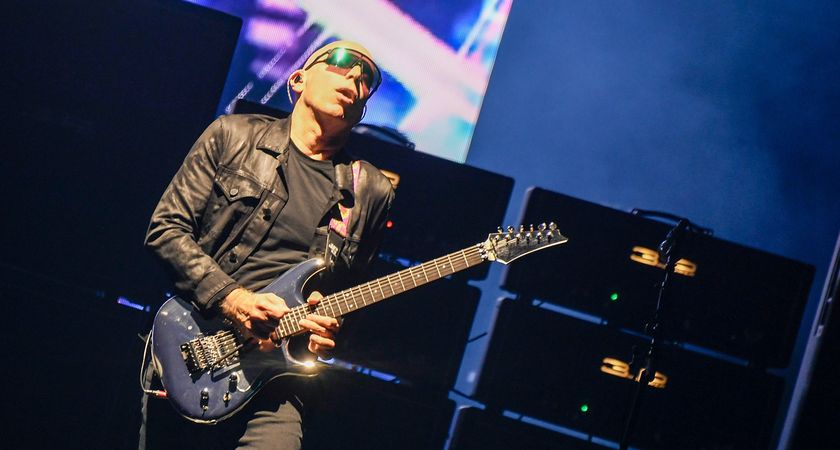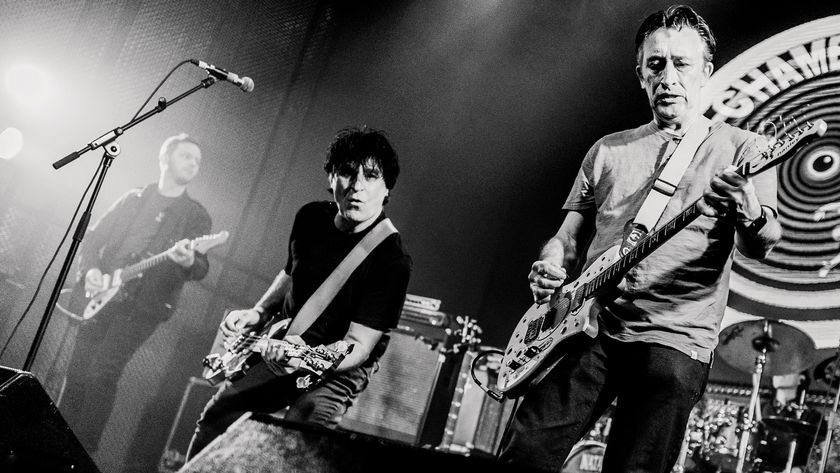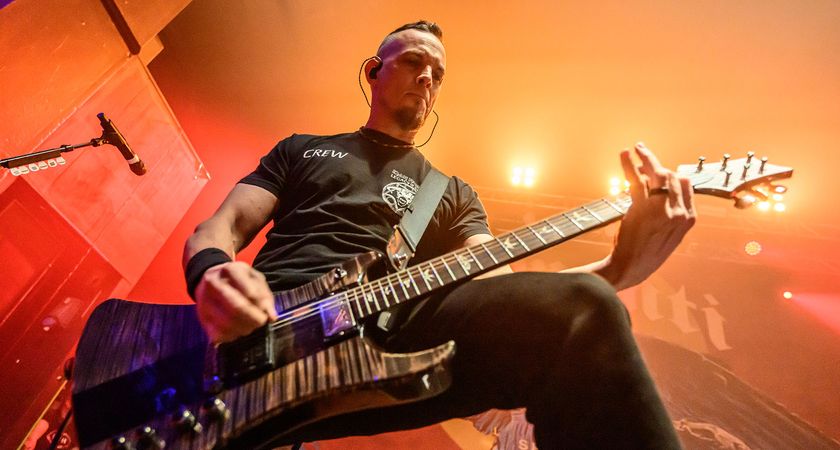“Verböten played right across the street from Wrigley Field. Dave Grohl came with his sister when he was 13 and saw us play”: Jason Narducy on inspiring Dave Grohl, getting R.E.M. cover tips from Peter Buck – and being Bob Mould’s bassist
Starting his punk band Verböten at 11 with a “terrible” SG copy, the modest guitar hero (and Bob Mould bassist) remains in demand with his eternal passion, attention to detail and love of living room shows

The obsession that took over Jason Narducy’s life led to the formation of cult Chicago punk rock act Verböten, who played clubs in the shadow of Wrigley Field and, one night, inspired Dave Grohl to get into music.
“I didn’t know anybody that had an electric guitar, as a kid or adult,” Narducy tells Guitar World of his epiphany at 11 years old. “It was beyond my wildest imagination that it was possible. I slept with that guitar – that’s how obsessed I was.”
A band formed at such a young age wasn’t likely to last. “Verböten was together for like a year and a half,” he explains. “But now, because of Dave shining the spotlight on us, there’s more interest. That’s why we just made a record and played our first show in 41 years at Riot Fest.”
Narducy wouldn’t say he’s close with Grohl. "We know each other; we’ve spent a lot of time together. He’s very sweet to credit us with all that, because we were just ambitious kids trying to do our thing. It’s very sweet that it inspired him.”
Meanwhile, Narducy – who operates in solo format as Split Single – has become bass mainstay for Bob Mould and has regular touring guitarist gigs with Superchunk and Sunny Day Real Estate. Alongside Michael Shannon he pays homage to classic R.E.M. cuts. Asked why he's stayed in demand, Narducy shrugs.
“I’ve just been fortunate. Maybe I have a reputation of being easy to work with… but mostly I’m just really fortunate.”
What first stoked your interest in guitar?
Get The Pick Newsletter
All the latest guitar news, interviews, lessons, reviews, deals and more, direct to your inbox!
“When I was 10, my divorced parents were very far from each other in Chicago. My mom was on the South Side; I would see her every other weekend. For Christmas, she and my stepdad brought me an SG copy with a hardshell case. It was kind of a terrible guitar, but it meant everything to me. And I immediately formed a band.”
Was that band Verböten?
“Yeah – I started the band when I was 11 in Illinois with my neighbors Zack Kantor and Chris Kean. We brought in a young woman named Tracey Bradford, who went to school with me, and we came up with Verböten.
“Tracey was – and still is – a very charismatic, personable human who made friends with all these punk rock bands. She would get us gigs; when I was 11, we played at The Cubby Bear, right across the street from Wrigley Field, and her cousin happened to be Dave Grohl.
“Dave came with his sister when he was 13 and saw us play. When he made his Sonic Highways HBO show, he interviewed me and Tracey and showed footage of Verböten. Then he wrote a book called Storyteller, and there's a chapter about Verböten called Tracey is a Punk Rocker.”
When did you find your sound on guitar?
“I started playing Fender Strats in my early 20s, and that guitar felt right in my hands. I’m not much of a gear person. I’ve had just a distortion pedal, a tuner and maybe some delay and reverb. I just felt I should spend time writing songs instead of playing with toys – though now, I see the value.”

How did you end up playing bass for Bob Mould?
“When I was demoing songs I played a lot of bass. Bob knew that because he produced a record of mine. He was thinking about putting a band together, and I think he wanted strong backing vocals, and knew I could do that. And he had faith that I could become a better bass player!”
What did your bass rig look like when you joined Bob’s band?
“It’s still a Fender P-Bass, but when I first went out with Bob, I had a Fender Rumble bass head for 4x10s. Then I ran custom cabinets – it was kind of a massive rig because I knew I was going against Bob's volume. Since then I’ve been endorsed by Orange.”
Peter Buck was holding a guitar… there was like 10 seconds of silence then he said, ‘When I’m doing Driver 8…’ and he starts showing me
What’s the most important lesson you’ve learned while playing with Bob?
“Pick your spots – especially when we make records. When I’m tracking a bass part he’s usually behind me, and I’ll do the version I hear. We'll talk about where it needs to be simpler and where I have room to do some counter melodies, responses or a wheelie. Just something that will give the song a lift.”
Lately you’ve been working with Michael Shannon and performing R.E.M. songs. How do you approach that?
“That’s one of the most unlikely things that’s ever happened to me. Michael and I have this super low-pressure, fun hobby: for the last 10 years, he’d be like, ‘Hey, I’m going to be in Chicago; do you want to play a show?’
“We just pick a record, learn the whole thing, and perform it. I love it because it’s like a pop-up band. As musical director, I’ll find musicians who fit the record. We’ll practice the night before then play the show. There’s something exciting about that – it’s kind of like getting deep inside a record, performing it once, and it’s gone.”
Your homage to Murmur has taken on a life of its own.
“It just erupted! Not only in ticket sales, but I also started getting emails from promotors around the country asking if we could bring the show to them. So this year we did a nine-day mini-tour. That went so well that we're doing a much longer one next year.
“The last show on the last tour, I woke up in my New York hotel and got a text from a friend, who also is a promoter. He said, ‘I love when the weird ideas work.’ That’s exactly what this is – this really weird thing that’s so much fun; and thankfully, people are interested in it.”
What gear do you lean on when playing R.E.M. songs?
“My friend Dag Juhlin has a Rickenbacker, so I thought, ‘I don’t want two Rickenbackers on stage – they’ll cancel each other out.’ Peter Buck is best known for playing a Rickenbacker, but I’m more of a Strat guy. So I got what’s called a Fender American Ultra, and I just love it so much. It’s become my main guitar.

“With most of the R.E.M. records there are two guitars involved, so it’s fun to get inside and do our best to figure out how to recreate that. We’re not a tribute band; we’re just celebrating the music. But we want it to sound like the records.”
The guys in R.E.M. came to a show, right?
“Yeah, the entire band came out to our Athens, Georgia show. That was mind-blowing. They actually got on stage and thanked us. But before the show, Peter Buck watched our soundcheck, Afterward he said, ‘You’re using different voicings than I do on the records – but it sounds good.’
I’m more of a gear person now, and I attribute that to my work with Sunny Day Real Estate. They’ve made me a better guitar player
“I said, ‘Oh, thank you! I’m just doing my best to listen and recreate your incredible parts .’ He was holding a guitar while saying this, and there was like 10 seconds of silence… then he said, ‘When I’m doing Driver 8…’ and he starts showing me. Man, I felt so lucky. I picked his brain for about 20 minutes.”
You’ve been touring with Sunny Day Real Estate too. How did you get the gig?
“In the early ‘90s I met a guitarist named Greg Suran. He’s very versatile – he plays with Lionel Richie and he's on American Idol. He’s played with Joe Walsh, and he played with Sunny Day.
“He was like, ‘I love this, but I can’t do all the shows. Can I have my friend Jason sub for me?’ So that’s how I got the work. I had met Jeremy Enigk and Will Goldsmith before but I didn’t know them well enough to be like, ‘Oh, I’d like to play with you guys.’”
Were you worried about how you’d fit in, given that it’s already a two-guitar band?
“I have to admit, when they did ask me, I thought, ‘Oh, three guitars… It’s going to be like Scorpions – just power chords!’ I didn’t realize how intricate the playing would be. It’s a lot of single-note runs and effects pedals, so I’ve got to be agile with my feet.
“I’m more of a gear person now, and I attribute that to my work with Sunny Day Real Estate. They’ve made me a better guitar player. Greg has been a huge help. I just love playing with those guys. The music means a lot to me, they’re easy to work with, and the shows are fun.”
What’s next for you?
“I’m on tour right now with Superchunk then I’m doing a ton of solo shows in November and December. I do a living room circuit where you play to 30 to 50 people every night, telling stories and playing songs. I love those intimate shows.
“Next year I’ve got the Michael Shannon tour starting in February, going through mid-March. There’s also talk of some more Bob Mould stuff – we’re still working on all that.”
- Check out Jason Narducy’s LinkTree for details of his upcoming projects.
Andrew Daly is an iced-coffee-addicted, oddball Telecaster-playing, alfredo pasta-loving journalist from Long Island, NY, who, in addition to being a contributing writer for Guitar World, scribes for Bass Player, Guitar Player, Guitarist, and MusicRadar. Andrew has interviewed favorites like Ace Frehley, Johnny Marr, Vito Bratta, Bruce Kulick, Joe Perry, Brad Whitford, Tom Morello, Rich Robinson, and Paul Stanley, while his all-time favorite (rhythm player), Keith Richards, continues to elude him.

“It’s a whole new generation in sound. There’s nothing lacking”: Alex Lifeson reveals the gear that has finally converted him to digital modeling

“The Strat is the most versatile electric guitar that there is; but the Les Paul is a perfect instrument”: Sting guitarist Dominic Miller weighs in on the Strat vs. Les Paul debate – says the Strat loses despite being a more versatile instrument











